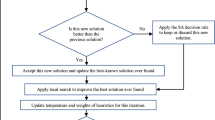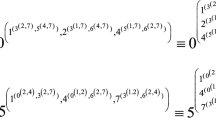Abstract
A liveness enforcing supervisor synthesis technique is presented for Petri net modeling automated manufacturing systems. The insufficiently marked siphons are deployed to characterize the deadlock situations in an incidence matrix based way, which makes possible the study of the modeled systems from both structural and algebraic perspectives. The approach generates at each step a generalized mutual exclusion constraint which contains only markings for which liveness can be enforced. To avoid the explicit enumeration of all the set of strict minimal siphons, a set of mathematical programming formulations are established to implement the derivation of insufficiently marked siphons from the PT-transformation of the plant system. Further, a generalized elementary siphon control approach is involved such that the final supervisor can be structurally simplified. Several examples are used to illustrate these results.
Similar content being viewed by others
References
Abdallah I.B., ElMaraghy H.A. (1998) Deadlock prevention and avoidance in FMS: A Petri net based approach. International Journal of Advanced Manufacturing Technology 14(10): 704–715
Barkaoui, K., Chaoui, A., & Zouari, B. (1997). Supervisory control of discrete event systems based on structure theory of Petri nets. In Proceedings of IEEE Conference on Systems, Man, and Cybernetics, Paris, France (pp. 3750–3755).
Barkaoui, K., & Peyre, J. F. (1996). On liveness and controlled siphons in Petri nets. In J. Billington & W. Reisig (Eds.), Proceedings of International Conference on Application and Theory of Petri Nets, Lecture notes in computer science (Vol. 1091, pp. 57–72). Berlin: Springer.
Chao D.Y. (2007) Max*-controlled siphons for liveness of S 3 PGR 2. IET Control Theory and Applications 1(4): 933–936
Chu F., Xie X.L. (1997) Deadlock analysis of Petri nets using siphons and mathematical programming. IEEE Transactions on Robotics and Automation 13(6): 793–804
Ezpeleta J., Colom J.M., Martínez J. (1995) A Petri net based deadlock prevention policy for flexible manufacturing systems. IEEE Transactions on Robotics and Automation 11(2): 173–184
Hsieh S., Shih Y.-J. (1992) Automated guided vehicle systems and their Petri-net properties. Journal of Intelligent Manufacturing 3(6): 379–390
Hu, H. S., & Li, Z. W. (2009). Liveness enforcing supervision in video streaming systems using siphons. Journal of Information Science and Engineering (to appear).
Huang Y.S., Jeng M.D., Xie X.L., Chung D.H. (2006) Siphon-based deadlock prevention policy for flexible manufacturing systems. IEEE Transactions on Systems, Man, and Cybernetics-Part A 36(6): 1248–1256
Iordache M.V., Antsakis P.J. (2003) Design of T-liveness enforcing supervisors in Petri nets. IEEE Transactions on Automatic Control 48(11): 1962–1974
Jeng M.D., Lin C.S., Huang Y.S. (1999) Petri net dynamics-based scheduling of flexible manufacturing systems with assembly. Journal of Intelligent Manufacturing 10(6): 541–555
Jeng M.D., Xie X.L. (1999) Analysis of modularly composed nets by siphons. IEEE Transactions on Systems, Man and Cybernetics 29(4): 299–406
Lautenbach, K., & Ridder, H. (1996). The linear algebra of deadlock avoidance—a Petri net approach. University Koblenz, Institue of Computer Science, Germany, Technical Report, 1996.
Li Z.W., Zhou M.C. (2004) Elementary siphons of Petri net and their application to deadlock prevention for flexible manufacturing systems. IEEE Transactions on Systems, Man and Cybernetics-Part A 34(1): 38–51
Misra K.B., Sharma U. (1991) An efficient algorithm to solve integer-programming problems arising in system-reliability design. IEEE Transactions on Reliablility 40(1): 81–91
Moody J.O., Antsaklis P.J. (2000) Petri net supervisors for DES with uncontrollable and unobservable transitions. IEEE Transactions on Automatic Control 45(3): 462–476
Murata T. (1989) Petri nets: Properties, analysis and application. Proceedings of IEEE 77(4): 541–579
Ohta, A., & Tsuji, A. (2003). Insufficiently marked siphon of Petri nets—extension of token-free siphon. In Proceedings of IEEE International Symposium on Circuits and Systems (pp. III244–III244), Bangkok, Thailand, 2003.
Park J., Reveliotis S.A. (2001) Deadlock avoidance in sequential resource allocation systems with multiple resource acquisitions and flexible routings. IEEE Transactions on Automatic Control 46(10): 1572–1583
Reveliotis S.A. (2003) On the siphon-based characterization of liveness in sequential resource allocation systems. In: van der Aalst W.M.P., Best E. (eds) Proceedings of International Conference on Application and Theory of Petri Nets, Lecture notes in computer science (Vol. 2679). Springer, Berlin, pp 241–255
Souissi Y. (1991) On liveness preservation by composition of nets via a set of places. In: Goos G., Hartmanis J. (eds) Advances in Petri nets Lecture notes in computer science (Vol. 542). Springer, Berlin, pp 277–295
Tricas, F., Colom, J. M., & Ezpeleta, J. (1999). A solution to the problem of deadlocks in concurrent systems using Petri nets and integer linear programming. In Proceedings of the 11th Europe Simulation Symposium (pp. 542–546), Erlangen, Germany.
Tricas, F., García-Vallés, F., Colom, J. M., & Ezpeleta, J. (2005). A Petri net structure-based deadlock prevention solution for sequential resource allocation systems. In Proceedings of International Conference on Robotics and Automation (pp. 272–278), Barcelona, Spain.
Uzam M., Zhou M.C. (2006) An improved iterative synthesis approach for liveness enforcing supervisors of flexible manufacturing systems. International Journal of Production Research 44(10): 1987–2030
Xing K.Y., Hu B.S., Chen H. (1996) Deadlock avoidance policy for Petri net modeling of flexible manufacturing systems with shared resources. IEEE Transactions on Automatic Control 41(2): 289–295
Author information
Authors and Affiliations
Corresponding author
Rights and permissions
About this article
Cite this article
Hu, H., Li, Z. Synthesis of liveness enforcing supervisor for automated manufacturing systems using insufficiently marked siphons. J Intell Manuf 21, 555–567 (2010). https://doi.org/10.1007/s10845-009-0238-1
Received:
Accepted:
Published:
Issue Date:
DOI: https://doi.org/10.1007/s10845-009-0238-1




